 United Kingdom (1941)
United Kingdom (1941)
Infantry Tank – 7,368 Built
The last “infantry tank”
The A.20 British infantry tank design was a prewar General Staff specification, meant to be a replacement for both the Matilda and the recent Valentine. Just like the former, it incorporated typically trench-warfare features. It was envisioned as slow (infantry pace), heavily protected with an armament only suitable to deal with fortifications (low velocity, high caliber, high explosives), crushing barb wire in the process. The tracks had to be long enough to allow large trench crossings, including anti-tank ditches.
| Hello dear reader! This article is in need of some care and attention and may contain errors or inaccuracies. If you spot anything out of place, please let us know! |
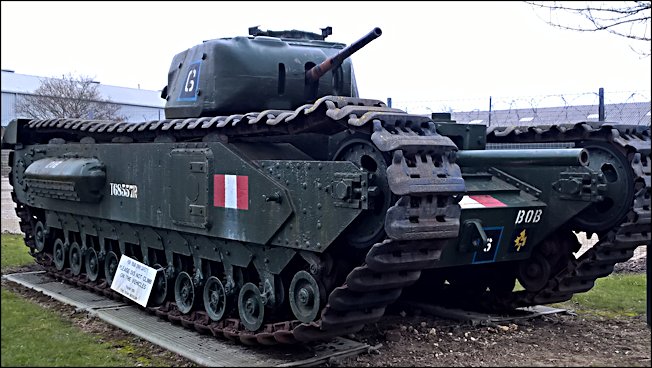
British Churchill Mk.II A.22 Infantry Tank on display outside the Tank Museum, Bovington, England
The first design had a strong WWI flavor, with two QF 2-pdr ordnance guns placed in side sponsons, a reminder of the “lozenge design” of the Great War. But this obsolete design soon incorporated a 60 mm (2.36 in) steel protected turret, like the one on the Matilda. The initial engine was the 300 hp flat-12 Meadows already used by the Covenanter cruiser tank. The A.20 final design was approved and a contract order was signed for two prototypes, to be assembled by Belfast shipbuilders Harland and Wolff (original makers of the famous Titanic). These two prototypes were delivered in May 1940.
Various weapons combinations were tried, ending with a 3 in (76.2 mm) howitzer. However, the A.20 proved sluggish, its 43 tons overwhelming the engine. One prototype was shipped to Vauxhall Motors, at Luton, to try to enhance its performance with a revised, lighter design, and more powerful engine. They devised a strange arrangement, called the “twin six”, in fact a “flat-12” Bedford. This was the blueprint for the A.22.
The A.22, Tank, Infantry Mark IV
During the battle of France, the initial design, based on trench warfare, was proved to be obsolete, and a new one was envisioned by Dr. H.E. Merritt, the Woolwich Arsenal Tank Design director. This model was then shipped to the Vauxhall factory at the end of June 1940. An initial order was given for two prototypes, delivered by Vauxhall in December 1940. But, more refinements, trials and modifications were needed before production could start, and the first Mark I rolled out of the factory line in June 1941.
The A.22, Tank, Infantry Mk.IV (the Mk.III was the Valentine) might seem like it was named after the iconic British leader of the time. But -according to Churchill himself- the name honored the memory of his XVIIth century ancestor, Sir John Churchill, 1st Duke of Marlborough. It could also have commemorated the instrumental leadership of Sir Winston Churchill, then First Lord of the Admiralty, and the head of the “Landship Committee”, the initiator of British tank development during the Great War.
Design of the A.22
Suspension and drivetrain
At the opposite spectrum compared to the nimble Cruisers, with their Christie-style suspensions, the Churchill was a kind of “back to basics” and had a suspension system only tailored for large trench crossing and impassable or extremely muddy terrain. Since protection was also paramount, both the size and weight had to be compensated by minimal possible ground pressure. The engineers did it the old way, by adding multiple small road wheels, each sprung by sturdy coil springs, interlocked with the biggest and heaviest track links designed for a British tank up to that point. The 58 track links rolled under 22 paired ground 10-inch (25.3 cm) roadwheels (11 bogies), of which two were posted at the front for unditching and two at the rear, serving as track tensioners.
There were no return rollers, as the tracks ran above “panniers”, which cleared the sides for an access hatch. The drive sprockets were at the rear, and idler at the front. At first, the upper tracks were left completely unprotected, like the typical WWI “lozenge” tanks. But this was changed in 1942 (with the Mk.III), and the upper tracks were entirely covered by “catwalks”, while the ends received massive mudguards. This WWI appearance owed to the hull being significantly shorter than the tracks, which protruded a good 40 in (1.2 m) to the front. This was done with cratered terrain and deep trenches in mind.
These mudguards were often removed from the tanks in theater. One reason was that mud would get clogged up inside them and cause them to be ripped off. Another reason was that the blast from the gun distorted them or blew them clean off.
Engine
The Churchill’s Bedford was a specifically built twin engine in an opposite horizontal configuration, mated on a common crankshaft. It was called the “flat twelve”. It had a 1.296 cubic inch capacity, rated at 350 bhp@2000 rpm (261 kW), giving a 960 lb/ft (1,300 N/m) torque for an rpm ranging from 800 to 1600.
Four Solex carburetors, with their own manifolds, each served three cylinders, forming a single head. All the engine components were ventilated around to provide easier access and maintenance inside the compartment. The air needed to cool the engine was drawn from the fighting compartment, dragging gun fumes through air cleaners when opening a flap between the two compartments. The engine fumes were exhausted into two large side louvres, one of the most recognizable features of the Churchill. These had various shapes during production, the early type being the “cylindrical” style. The cooled air was blown through the radiators by a fan actioned by the clutch. This fan also blew air onto the gearbox and towards the hull rear.
Transmission
The Merritt-Brown 4 speed constant mesh epicyclic gearbox was characterized by a regenerative steering system controlled by a tiller bar, instead of brake levers or a steering wheel. This caused concerns when training drivers, but the unconventional system had advantages of its own. It was rendered necessary by the sheer weight of the tank, which would have made it difficult to control with a modern hydraulically-driven servo assistance. A system, mirroring the complex oil-driven steering mechanism on the French B1 tank, which was also meant to aim very precisely the hull’s main gun, an armament configuration also adopted on the first Churchill. The system also allowed to change the relative speed of each track, providing, ultimately, a “neutral turn” capability. The tank could turn entirely on the spot, which was a crucial capability given the size and weight of the hull. The drive sprockets were planetary-type final reduction gears.
Hull
The 1940 specifications (A.20) called for a riveted hull. This was the norm until the Mk.VII (A.22F), on which all plates were welded. These were simple flat armored plates, bolted to the steel chassis. The hull was long, but relatively narrow, in accordance with the standard wagon lorries of the Army. Access to the inside was performed through two side hatches, round or squared. Two massive storage boxes were fitted to the rear, on each side of the engine compartment. The driver compartment was not separated from the fighting compartment in the middle, which was roomier than usual.
The original armor specifications called for 0.63 to 4 in armor thickness (16 to 102 mm), which was greater than that of the Matilda, and promised near immunity against most antitank guns of the time, or heavy shrapnel. It was, in 1941, the most heavily protected tank in the world (the Russian KV-1 being second). The Germans had nothing comparable until the Tiger I was out, but, in the meantime, the armor was considerably reinforced. By the time the Mark VII was operational in 1943, the frontal armor had reached a staggering 6 in (152 mm), while the minimal thickness (bottom) was raised to 0.98 in (25 mm), with sides up to 102 mm (4 in). Only the rare Tiger II and Jagdtiger surpassed it on this matter. The only problem was that the armor was vertical, losing efficiency compared to a sloped one. Nevertheless, this protection gave tremendous confidence to the crews.
Turret
The early turret was relatively small compared to the hull, entirely cast, rounded, and wide enough to accommodate the commander and servants of the standard 2-pdr (40 mm/1.57 in) gun. The mantlet, both for the main gun and coaxial Besa machine gun, was internal. There were three vertical slots, with the rangefinder optics at the right, gun in the center and coaxial machine-gun on the left, slightly off-centered. A small storage bow was later fitted to the turret’s rear, at first to give extra storage, but, at the end of the Churchill development, also to provide a counterweight following gun upgrades. A second storage was added to the left side. The Vickers Tank Periscope Mk.IV was soon adopted. There were two of them, one for the gunner, another for the commander, on each side of the turret, and, behind them, two half-door hatches. Two other periscopes were fitted on the hull, over the hull gunner and driver positions, both of them being provided with roof exit hatches. As customary, the radio compartment was fitted at the rear of the turret, with two antennae.
With the Mk.III, the turret was enlarged, in order to house the bigger 6-pdr (57 mm/2.24 in). It was now hexagonal, with flat sides, welded, and significantly taller and wider. The gun and machine-gun were now narrowly coupled on the same mantlet, which was internal.
The last evolution came with the Mk.VII. The turret, still hexagonal and angular, was partly cast and welded, asymmetric, and lengthened at the rear, to house a bigger 75 mm (2.95 in) gun. The internal mantlet was holding together, in a narrow configuration, the main gun, the coaxial Besa and the gunner optics. Two deflector bulges were welded on each side of this opening, to deflect incoming rounds from sensitive angles.
Armament
The early idea of lateral barbettes being dropped, there were still concerns about the main armament. In the end, a compromise inspired by the French B1 was chosen, with a 3 in (76.2 mm) hull howitzer to deal with concrete fortifications, while retaining antitank capabilities with the standard 2-pounder (40 mm/1.57 in), mounted in the turret. In 1940, it was certainly superior to most 37 mm (1.45 in) guns in service throughout the world at that time, with an excellent muzzle velocity and a great rate of fire. Another early variant was the Mk.II CS (Close Support), fitted with a 3 in (76.2 mm) howitzer, which was only capable of firing smoke shells. The hull gun proved inefficient and was replaced, on the Mk.III, with a hull machine-gun. Only in 1942, when the real AT capabilities of the puny 2-pdr appeared blatantly inefficient against superior German armor, did concerns appear about upgrading the main armament, which also required a new turret.
This came along with the Mk.III, fitted with the standard 6 pounder (57 mm/2.24 in) gun, and a completely new turret and internal configuration. This gave the Churchill the long-awaited capability of going against up-armored Panzer III/IVs in North Africa and proved instrumental during the second battle of El Alamein. However, by the time of the Tunisian campaign, the upgraded Panzer IV Ausf.F2 proved to have superior range and penetration power.
Once again, a new upgrade was envisioned. But even before that, a clever and resourceful officer, named Percy Morell, managed to fit spare US-built 75 mm (2.95 in) guns inside the regular Churchill IV turrets, obtained from countless disabled Sherman tanks. The result, known as the “NA-75”, fought during the final phase of the Tunisian campaign, and again in Normandy. But even the Sherman main gun was not up to the task, and the Mk.VII, or “heavy Churchill”, was the first to introduce the QF 75 gun (75 mm/2.95 in), which had better characteristics than the 6-pdr, but still lacked punch against the latest German tanks, like the Tiger or Panther. The final attempt to fit the “long” 17-pdr version came too late, with the “Black Prince”. Only prototypes were built, and never saw action. By that time, more modern tanks were in the final development stage, like the Centurion.
Production & evolution
The early A.22 Mk.I was not so different externally from the later Mk.VII/VIII. However, almost everything had been changed in the meantime, making these later versions the best of any. This triggered a wave of upgrades and modifications of previous versions (leading to the Mk.IX, X, XI). This renders it tricky to determine, in the study of photographic evidence, if the tank was of one the upgraded types, or a late “regular” one. The turret shape is a good clue, as are the side details. The late Churchills were the most heavily armored, best armed, but also the slowest of the entire series. A famous offspring of this lineage, the A.43 “Black Prince”, was an attempt to give the British Army a heavy tank capable of dealing, on equal terms, with its latest German counterparts, but had nothing to do with the early infantry tanks.
Churchill Mk.I
First series, with 303 built in 1941. The tracks were entirely unprotected. This series was characterized by an early rounded turret with the 2-pdr QF standard gun, coupled with a 3 in (76.2 mm) hull howitzer. Plagued by teething problems, they were relegated to training or reconverted into special versions.
Churchill Mk.II (Churchill Ia)
The hull howitzer was replaced by a Besa machine-gun, in order to gain extra space and simplify production. 1127 delivered until mid-1942. Many problems had to be overcome until 1943. Also relegated to the second line or reconverted.
Churchill Mk.II CS (close support)
The turret 2-pdr and the hull 3-in howitzer swapped places. Supplied with smoke rounds. Proved quite unsatisfactory. Only a handful built.
Churchill Mk.III
The first major set of modifications. For the first time, the turret was welded and housed a 6 pdr gun. It had a coaxial Besa machine gun, another one replacing the former hull howitzer. Many changes to the engine, transmission and protection were made, including the “catwalk” above the upper tracks. 675 were delivered in 1942.
Churchill Mk.III*
Field conversion replacing the 6-Pounder gun of Mk.III Churchills with the 75mm Gun.
Churchill Mk.IV
The biggest production of all series, with 1622 tanks. It was given the cheaper and less labor-intensive cast turret. The early production models had a counterweight to balance their 6 pdr gun, and many were retrofitted with the new long barrel 6 pdr (57 mm/2.24 in) Mk.V gun.
Churchill Mk.V
This was basically a Mk.IV for close support, with a 95 mm (3.74 in) howitzer and 47 rounds. 241 built in all in 1943.
Churchill Mk.VI
A minor upgrade of the IV, with the new 6 pounder Mk.V gun. 200 were built, but production was quickly swapped for the new VII, and the factory lines were then busy upgrading III/IV versions to the new standard.
Churchill Mk.VII
A major modification, which was also called “heavy Churchill”, was two ton heavier, better protected than ever, with 152 mm (6 in) of frontal armor, and the new QF 75 (75 mm) gun. This version was reclassified as the Ordnance A.42 in 1945. Production was around 1400, built until late 1944.
Churchill Mk.VIII
This last version was a close support one, fitted with a 95 mm (3.74 in) howitzer and 47 rounds. Around 200 were built in 1944.
Upgraded versions
The following marks were not new production vehicles, but completely overhauled and upgraded earlier models, so production figures are irrelevant. Many were also modified as more radical variants and sub-variants.
Churchill Mk.IX
Mk.III/IV refitted with the new Mk.VII turret, transmission and suspension. Some only received the latter improvements and kept their old turret. These were known as Mk.IX LT (for “light turret”). No upgrades in armor.
Churchill Mk.X
Mk.VI upgraded to the Mk.VII standard.
Churchill Mk.XI
Mk.V upgraded to the Mk.VII standard, but also receiving extra armor.
Churchill NA-75
Around 200 Churchill Mk.IVs were upgraded to the NA 75 version with 75 mm (2.95 in) guns and mantlets of discarded or destroyed Shermans. To mount the gun, the front turret section had to be cut off and the gun introduced, followed by mantlet slot, and then the whole package was welded over.
Operation Bertram
Another way of hiding your tank was to change its shape. This type of deception tactic had been used by the Royal Navy in WW1. They changed the outline of destroyers to look more like merchant ships. When the WW1 German U-boat surfaced to attack the ship with its main gun the screens would drop to enable a full broadside of high explosive shells to be fired at the submarine. These type of ships were called ‘Q’ boats.
During Operation Bertram in the months leading up to the second Battle of El Alamein in North Africa in September – October 1942 camouflage and dummy vehicles were used to deceive the Germans where the next attack was going to come from. Real tanks were disguised as trucks, using light “Sunshield” canopies. To achieve the deception, trucks were parked openly in the tank assembly area for some weeks. Real tanks were similarly parked openly, far behind the front. Two nights before the attack, the tanks replaced the trucks, being covered with “Sunshields” before dawn.
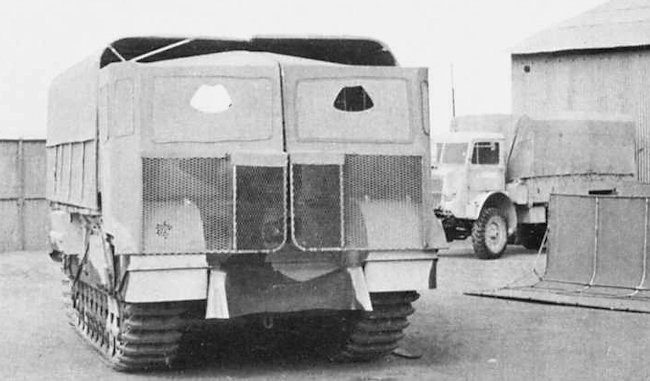
The tanks were replaced that same night with dummies in their original positions, so the armour remained seemingly two or more days’ journey behind the front line. Interviews with captured German senior officers showed that this type of deception was successful: they believed the attack was going to come from the south where they had seen the dummy tanks and vehicles and not in the north. The idea for the Sunshield came from Commander-in-Chief Middle East, General Wavell.
The first heavy wooden prototype was made in 1941 by Jasper Maskelyne, who gave it the name Sunshield. 12 men were needed to lift it. The Mark 2 Sunshield was made of canvas stretched over a light steel tube frame. On 11th November 1942, Prime Minister Winston Churchill announced victory at El Alamein in the House of Common.
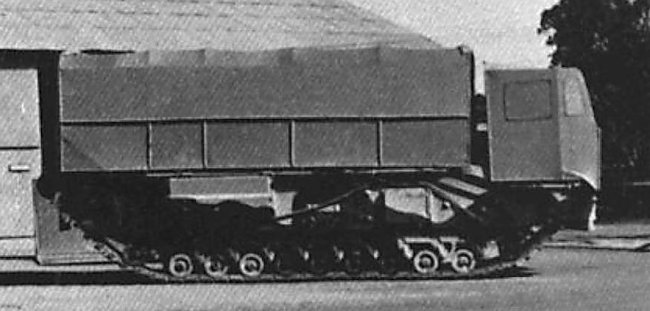
During his speech he praised the success of Operation Bertram, “By a marvellous system of camouflage, complete tactical surprise was achieved in the desert. The 10th Corps, which he had seen from the air exercising fifty miles in the rear, moved silently away in the night, but leaving an exact simulacrum of its tanks where it had been, and proceeded to its points of attack.” (Winston Churchill, 1942)
Special versions
Presented in chronological order. Many were derived from earlier series, never upgraded to the Mk.VII standard. These were popularly known by the common soldiers as “Hobart’s funnies”.
Churchill Oke
In mid-1942, prior to the upcoming raid on Dieppe, Major J.M. Oke devised a flame-throwing modification, applied to three prototype vehicles, named “Boar”, “Beetle” and “Bull”. A pipe apparatus, with the tank fitted at the rear, was linked to the front left hull Ronson flame projector, leaving the right-hand hull machine-gun unobstructed. The three vehicles were part of the first wave at Dieppe.
Churchill AVRE
The Churchill AVRE was most common modification of all genie versions, designed after the painful raid of Dieppe. This was the typical armored vehicle of the Royal Engineers, equipped with the Petard, a 290 mm (11.41 in) Spigot mortar, which fired an 18 kg (40 lb) warhead and had a practical range of 137 m (150 yards). Its purpose was to clear concrete bunkers and all kind of enemy fortifications and obstacles. It was a basis which could serve for many other purposes, like the mine-flail version, explosive carrier, fascine carrier, brideglayer, etc.
Bobbin carrier
This version was used during landings, on sandy beaches and soft grounds (extremely muddy) in general. A 10 feet large (3 m) canvas bobbin was carried at the front of the leading Churchill AVRE, released to create a rolling path for the following vehicles.
Double Onion
The Double Onion was the successor of the single carrot explosive device. It consisted of two large explosive charges placed on a metal frame, that was laid on a concrete wall and exploded from a safe distance. Another variant was the Churchill Goat.
Churchill ARV
The “Armored Recovery Vehicle” was based on a turretless Mk.I. The front jib had a 7.5 ton capacity and had a counterweight at the rear. The rear jib had 15 ton traction, while the winch could pull 25 tons. The small tailored turret had a dummy gun. A single Besa machine gun served for close quarter defense, and there was enough room inside to carry the damaged tank’s crew.
Churchill ARK
For “Armoured Ramp Carrier”, this turretless vehicle carried a folding bridge. When unfolded, it spanned 65 ft (20 m). The sub-Marks 1 and 2 had trackways either on the tracks or directly on the vehicle itself. In 1945, ten Churchill Great Easterns were delivered. These were conceived by officer engineer and inventor Cecil Vandepeer Clarke. The folded bridge spanned 60 feet and was deployed in seconds using rockets. It seems they never saw action.
Churchill Crocodile
One of the most famous versions of the Churchill, around 800 were built. It was the main Allied flamethrower tank (in Europe), generally a Mark VII with a flamethrower replacing the hull Besa machine gun. The fuel tank was carried in a trailer. The range was 150 yards (137 m), firing one-second bursts.
Churchill Kangaroo
A turretless variant used as an armored personnel carrier (APC). These were the roomier and best-protected versions of the Kangaroo.
Gun Carrier, 3in, Mk.I, Churchill (A.22D)
This was probably the only attempt to build a tank-hunter based on the Churchill. It was modified to house an anti-aircraft 3 in (76.2mm) Mk.I gun, in a ballmount inside a 3.5 in (88 mm) thick superstructure. Fifty were built in 1942, but their fate remains uncertain. Large scale conversions were dropped, due to the adoption of the 17 pounder.
Black Prince (A.43)
By 1943, the Churchill was the most heavily armored tank in British service, and it was seen as an adequate response to the German Tiger and Panther if rearmed with a more potent weapon, the 17 pounder. It was designed in 1944 on the basis of the Mk.VII at Vauxhall Motors, and adopted the turret developed for the Comet. But weighing ten tons more and having the same old engine, its performances were mediocre at best.
FV3902 Churchill Toad
The last use of the Churchill in military service. This heavy mine-clearing flail tank entered service, under the designation FV3902, in 1956 and was a descendant of the famous “Hobart’s Funnies”. 42 of the vehicles were produced, they served with the Royal Engineers but were never used in a combat environment.
FV3903 Churchill AVRE
The lesser-known update to the famous Second World War AVRE. The 290mm Petard Mortar was replaced with a 165mm Demolition gu which had a much-improved range. It had a short service life, before being replaced by the FV4003 Centurion AVRE.
Active service
When the A.20 was first planned, the general staff wanted a trench warfare tank. The specifications evolved by the summer of 1940, giving birth to the A.22. It was more powerful, and ease-of-manufacture simplifications were applied in order to reduce the time until it could enter production, which became paramount. Simply put, when the very first copies rolled off the line in July 1941, the Churchill had been rushed without proper trials and corrections. These would take place later and gradually, which hampered this tank early on, earning it an ill-deserved reputation, strengthened at Dieppe one year later.
North Africa
The most pressing problem, even more pressing after the first Mk.I/IIs arrived in North Africa, was the unreliability of the Meadows engine. Plus, it had been conceived for a mild climate and suffered heavily under the blistering sun of Libya. Ventilation was all-time poor and access limited, preventing efficient monitoring and maintenance. Despite being fitted with a 75 mm (2.95 in) howitzer, aiming the tank proved more difficult than expected and, by early 1942, the Germans introduced up-armored versions of their main battle tank, the Panzer III, fitted with a 50 mm (1.96 in) gun. The 2-pounder, shared with nearly all other British tanks of the time, was found lacking. Their presence was not felt before the second battle of El Alamein, when the first up-gunned and upgraded Mk.IIIs were first committed in action. The “King’s force”, comprising six Mk.IIIs, decisively supported the 7th Motor Brigade, destroying many German antitank gun positions. None was heavily damaged, and one was found with no less than 80 non-penetrating impacts. This success made the War Office send more, creating three armored regiments and a full brigade, that arrived in February 1943. All older version were withdrawn and shipped back to Great Britain for an overhaul.
The Dieppe Raid
Planned long before August 1942, Operation Rutter was to involve 6000 Canadians and several companies of Commandos. The force was meant to test German defenses and learn about landing operations. 60 Churchills of several types took part in the landings, including three flame-thrower versions, a Bobbin version, demolition and bridging vehicles. The operation proved a failure for a number of reasons.
It is a common myth that the Churchill tanks were stuck on the beach and could not cope with the shingle beach. Most of the Churchill tanks did get off the beach but could not get past some of the concrete tank traps. The few that could not get off the beach had their tracks clogged or broken by the pebbles. The reason most of the Churchill tanks ended up on the beach at the end of the raid is because they were called back to be taken off. Because of enemy fire, the landing craft could not get near the beach to take them off. The Churchill tanks that were knocked out were hit on their track and suspension system. They could not move so were abandoned by their crew. The German 3.7 cm (1.46 in), 5 cm (1.97 in) Pak and French 7.5 cm (2.95 in) guns had difficulty penetrating the Churchill tank’s armor. Only one tank had its armor penetrated.
Tunisia
When the Churchill began to arrive en masse in North Africa, the second battle of El Alamein had been won, and German forces were on the run west, to Tunisia. At the same time, the US and British forces landed in French Algeria and Morocco (Operation Torch), creating a giant pincer movement for the retreating Afrika Korps and what remained of the Italian divisions. Meanwhile, Marshal Kesselring was sent to Tunisia with massive reinforcements, including the German brand new beast, the Tiger. The Churchill III and IV, equipped with 6-pdr guns, were no match for it, but proved their tremendous protection and superior crossing abilities on many actions. Tunisia has a mountainous terrain, and over it, the Churchill motricity was second to none. It could climb up slopes which were deemed impassable for a tank, and so was able to provide infantry support where it was needed, often in areas unexpected by the enemy. On one occasion, a Churchill scored a lucky hit in the turret ring of a Tiger tank, jamming the turret. The crew hastily deserted it, leaving the Tiger as a prize. It was invaluable to British intelligence and now stands at the Bovington museum.
Italy
With its reputation firmly re-established, the Churchill was massively involved during the whole Italian campaign. The main reason was the terrain, favoring infantry, which in turn needed a sturdy support tank, able to deal with the difficult terrain. The Churchill was first in line for this task. The specialized versions of the armored engineers were vital to the entire VIIIth Army and many other Allied forces operating in Italy. The experience gained here also paved the way for better versions, which were massively engaged in Normandy. Most of the modified NA 75s saw action there. Their range and efficiency were better than those of a standard Sherman, due to the fact that the Churchill was a sturdier and more stable platform.
Western Europe
Although the Allies massively employed Shermans, the Churchill was always a welcome sight. Many specialized versions took part in the landings on the Normandy beaches, with mine-flail and Bullshorn plough versions, Bobbin versions, even salvage models. The Churchill, with its large tracks and many small boggies, proved invaluable in this sandy terrain. The heavy mortars of most of the AVREs (“petard”) dealt with any fortifications of the Atlantic Wall which had been missed by the planes. The excellent motricity of the Churchill was proven once more during Operation Bluecoat (30-31 July 1944), while capturing a key position, Hill 309. They also saw heavy fighting in the Low Countries.
On the Rhine border, equally fortified, the Churchill again proved highly efficient, especially with the arrival of the Mark VII, impervious to most German AT guns, or when combining a heavy mortar and flame-thrower versions. The “Crocodile” became infamously known for its macabre efficiency, so much so that in some cases, the simple view of one rolling towards a blockhouse triggered a prompt surrender. The Crocodile’s crews also knew too well that, in case they were captured, they could expect no mercy from the enemy. Churchills of all versions were massively engaged during Operation Veritable (the invasion of the Reichland).
Russia & Eastern Europe
The Churchill was also delivered to the USSR via Lend-Lease, a total of 301 Mk.III/IVs were shipped via Murmansk (43 lost en route). Their most memorable action occurred at Kursk, when the 5th Guards Tank Brigade successfully counter-attacked at Prokhorovka. The Russians appreciated the good mobility and large tracks of the vehicle, and excellent protection, comparable to the KV-1.
The Pacific
Less well-known, a few Churchills were also sent to the Australian forces operating in New Guinea, at the end of the war. By mid-1944, it was tested alongside the Sherman, with the Matilda already in service as a reference. The Australians eventually chose the Churchill, which was found very efficient for jungle warfare. However, only 46 of the 510 ordered ever reached the ANZACS, as the order was canceled at the end of the war.
Postwar
The last engagement of the Churchill came in Korea. In 1950, a Crocodile squadron took part in the third Battle of Seoul. Later on, four Churchills decisively supported the defense led by the 1st Battalion, Royal Northumberland Fusiliers, helping to maintain the Allied position there. The regular Churchill was retired from service in 1952, while special versions, like the bridgelayer, were still on active duty in 1970. Many survived and are on display in various museums and collections, some in running condition.
6pdr Main Gun penetration figures
Official British War Department test figures show that the 6pdr Mk.III anti-tank gun firing armor piercing AP rounds would penetrate the following thickness of homogeneous armour plate and these distances: 500 yrds. (457 m) = 79.5 mm; 1000 yrds (914.4 m) = 66.5 mm and 1500 yrds (1371.6 M) = 55 mm. When firing armor-piercing capped (APC) rounds at face-hardened armor plate these are the test results: 500 yrds. (457 m) = 87.5 mm; 1000 yrds (914.4 m) = 72 mm and 1500 yrds (1371.6 M) = 57.4 mm. When firing armour piercing capped ballistic capped (APCBC) rounds at face-hardened armor plate these are the test results: 500 yrds. (457 m) = 89.6 mm; 1000 yrds (914.4 m) = 79.6 mm and 1500 yrds (1371.6 M) = 70.7 mm. When fired at slopped armour it was estimated there would have been 80% success at 30 degrees’ angle of attack.
Official British War Department test figures show that the 6pdr Mk.V anti-tank gun firing armor piercing AP rounds would penetrate the following thickness of homogeneous armour plate and these distances: 500 yrds. (457 m) = 85.5 mm; 1000 yrds (914.4 m) = 72.5 mm and 1500 yrds (1371.6 M) = 60.4 mm. When firing armor-piercing capped (APC) rounds at face-hardened armor plate these are the test results: 500 yrds. (457 m) = 93.8 mm; 1000 yrds (914.4 m) = 76.3 mm and 1500 yrds (1371.6 M) = 61.25 mm. When firing armour piercing capped ballistic capped (APCBC) rounds at face-hardened armor plate these are the test results: 500 yrds. (457 m) = 95.9 mm; 1000 yrds (914.4 m) = 86 mm and 1500 yrds (1371.6 M) = 76.7 mm. When fired at slopped armour it was estimated there would have been 80% success at 30 degrees’ angle of attack.
A.22F Churchill Mark VII specifications |
|
| Dimensions | 24ft 5in x 10ft 8in x 8ft 2in (7.44 x 3.25 x 2.49 m) |
| Total weight, battle ready | 40 tonnes |
| Crew | 5 (commander, driver, co-driver/hull gunner, gunner, loader/radio) |
| Propulsion | Bedford twin-six petrol, 350 hp (261 kW) at 2,200 rpm |
| Transmission | Merritt-Brown 4 speed constant mesh epicyclic gearbox |
| Suspension | 22 vertical coil spring bogies |
| Top speed | 15 mph (24 km/h) |
| Range (road) | 56 mi (90 km) |
| Armament | Vickers QF 75 (75 mm/2.95 in) 2x 0.303 (7.7 mm) Besa machine-guns |
| Armor | From 25 to 152 mm (0.98-5.98 in) |
| Total production (Mk.VII-VIII combined) | 1600 |
Links about the Churchill tank
Gallery
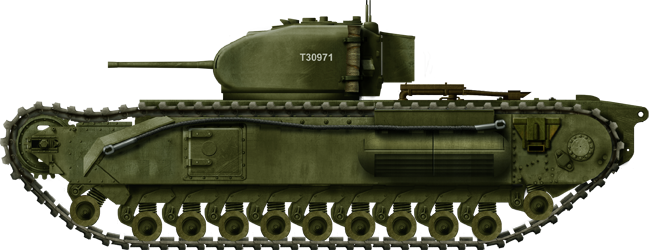
Churchill Mk.I with the early “cylinder” type side exhaust muffler, Great Britain, 1941.
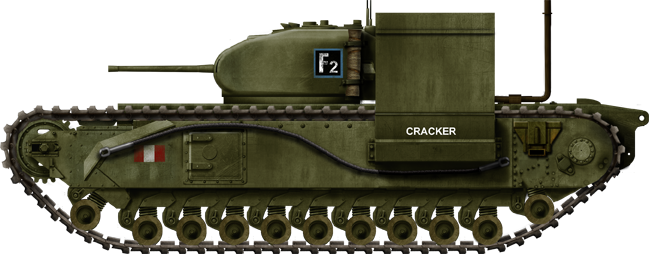
Churchill Mk.I, late production version, with deep wading gear, 14th Canadian Armored Regiment, Dieppe, August 1942.
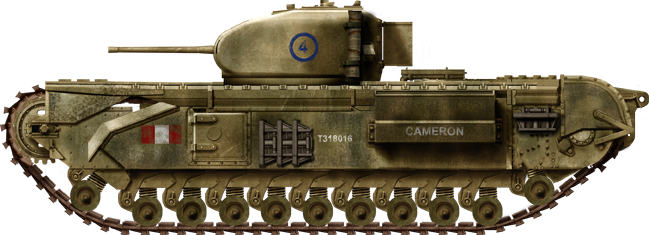
Reworked Churchill Mk.I, North Africa, fall 1942.
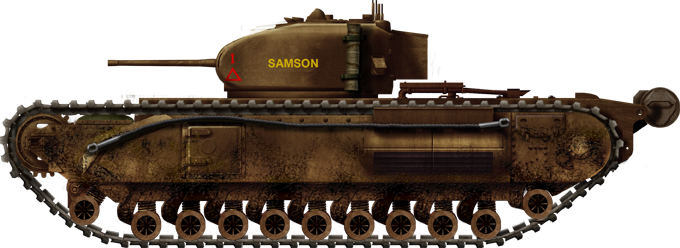
Churchill Mk.II from a training platoon on the Salisbury Plain, England, October 1942.
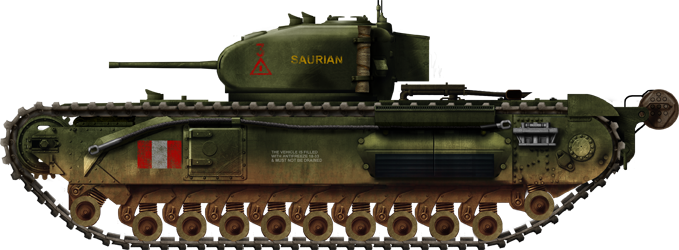
Churchill Mk.II “Saurian”, 43rd Royal Tank Regiment, 33rd Armored Brigade, 3rd Infantry Division.
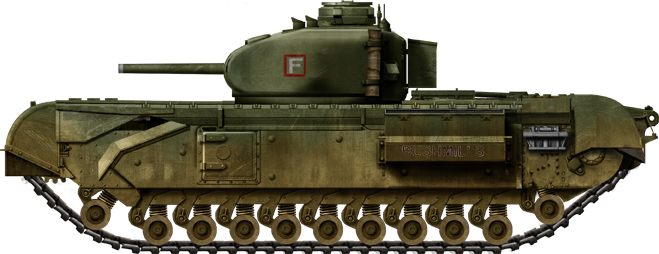
Reworked Churchill Mk.IICS (close support with a 95 mm/3.74 in howitzer), 21st Armored Tank Brigade, North Irish Horse Regiment, Company B, Normandy 1944. Notice the crew had managed to fit a captured Panzer III commander cupola over the main hatch.
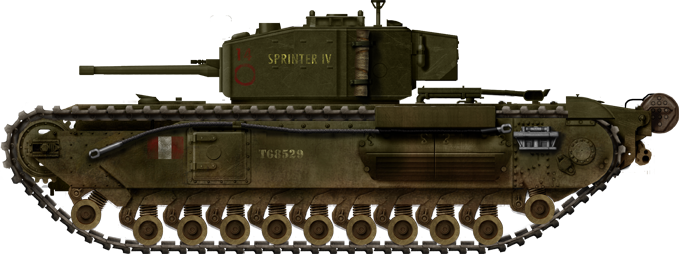
Churchill Mk.III (A.22B), early type, 43rd RTR, Italy 1944. Notice the late commander cupola fitted instead of the normal hatch.
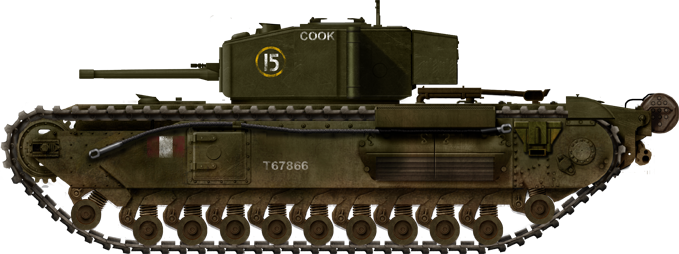
Early Mk.III from the 21st Tank Brigade, fall 1943.
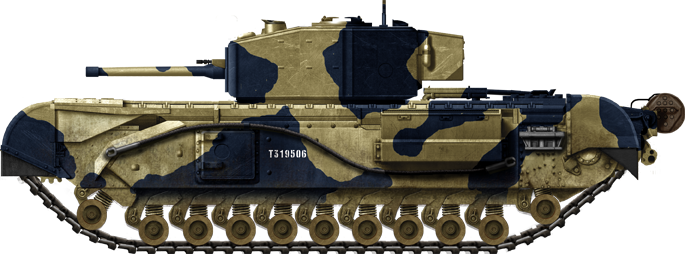
Reworked Mk.III, “King Force” detachment, battle of El Alamein, November 1942.
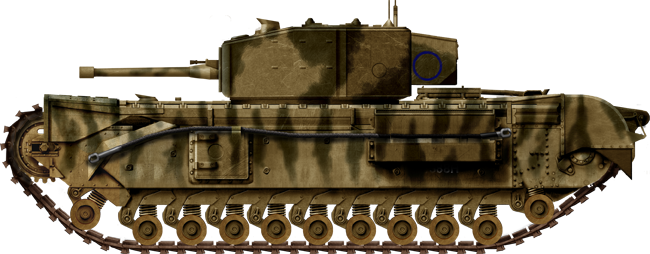
Reworked Mk.III, 152nd Regiment, Royal Armoured Corps, Tunisia 1943.
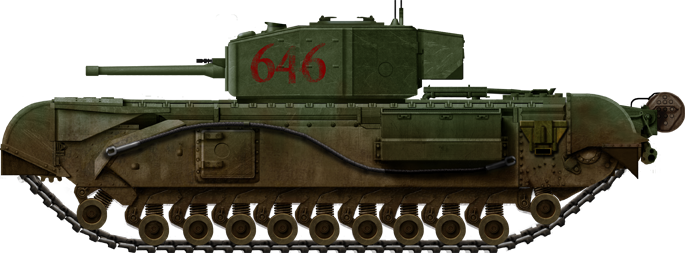
A late Churchill Mk.III in Russian service, Northern front, spring 1943.
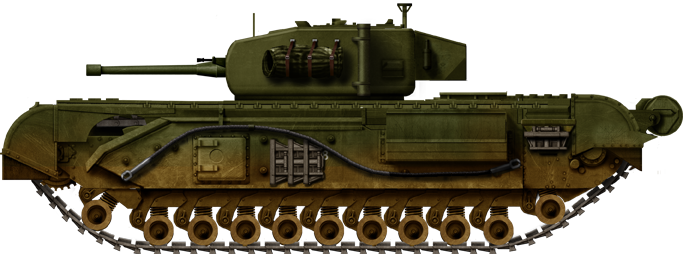
Churchill Mk.IV, cast turret model, 1943.
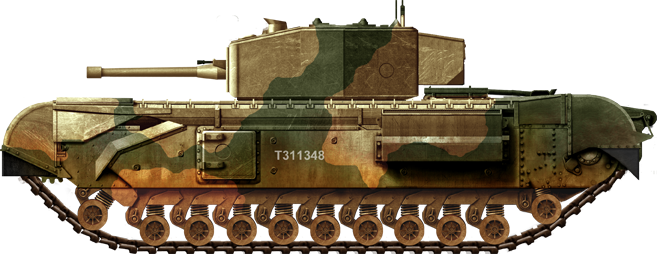
Churchill Mk.IV, welded turret model, Tunisia, fall 1943.
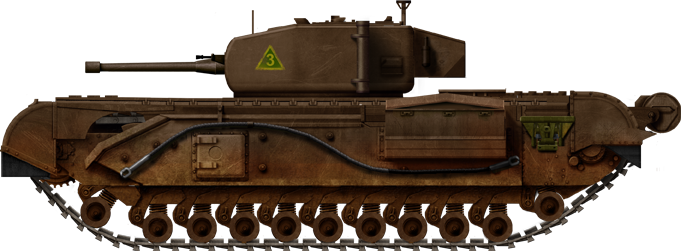
Churchill Mk.IV, cast turret, “A” Squadron, North Irish Horse, Tunisia, 1943.
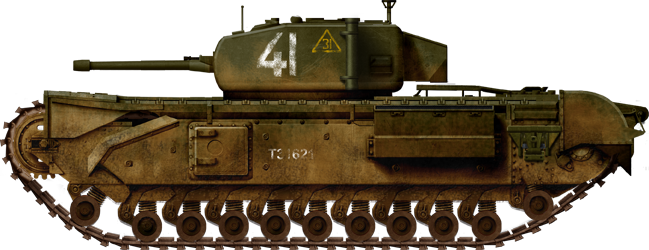
Churchill Mk.IV with cast turret, Russian 10th Guards heavy breakthrough Tank Regiment, 23rd Armored Corps, 1st Tank Army, Voronezh, 1943.
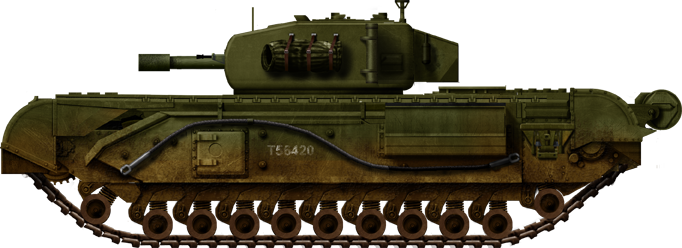
Churchill Mk.V or Mk.V CS, close support version armed with a 95 mm/3.74 in howitzer, 6th Guards Armored Brigade, fall 1944.
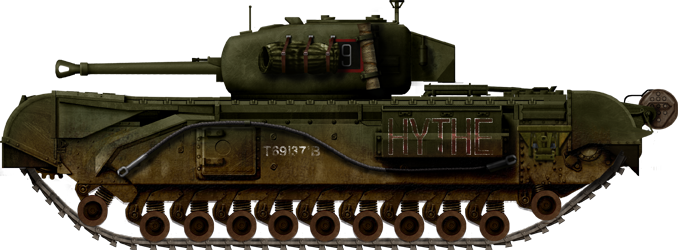
Churchill Mk.VI, 4th Guards Armoured Brigade, Western Europe, 1945.
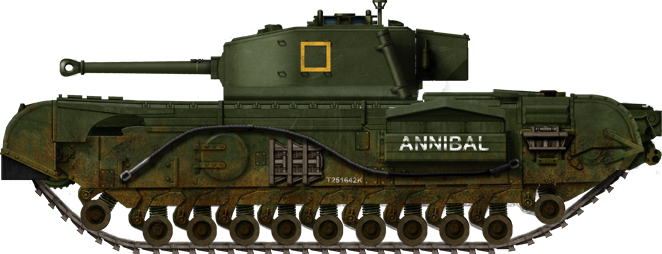
Churchill Mk.VII (A.22F) “heavy Churchill” from the 34th Tank Brigade, 107th RAC, 1944.
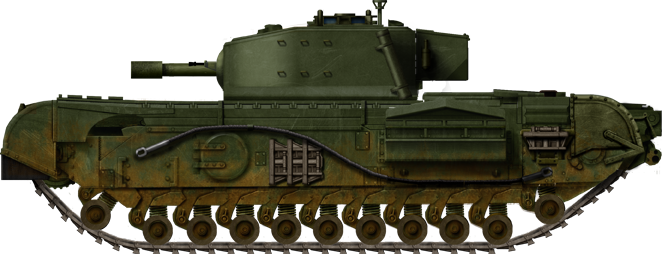
Mk.VII CS, or “close support”, 95 mm/3.74 in howitzer.
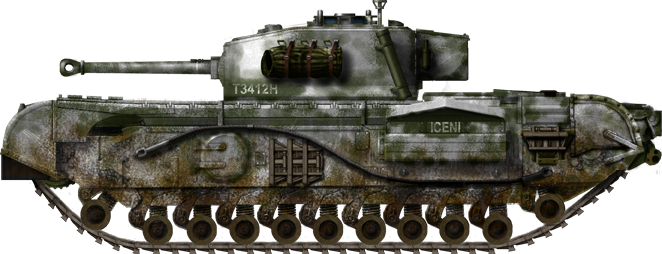
Churchill Mk.VII during the winter of 1945, western bank of the Rhine. The smaller round side hatch reduced the stress on the armored plate.
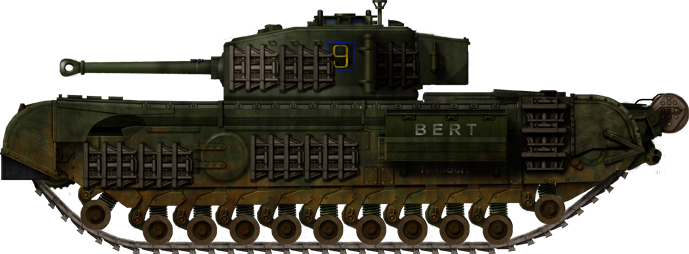
Churchill Mk.VII “Bert”, (unknown unit) with spare track links as additional protection.
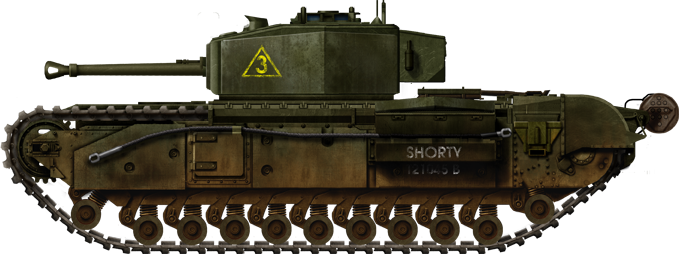
Churchill Mk.IX LT (“light turret”), with welded appliqué armor, 9th RTR, summer 1944.
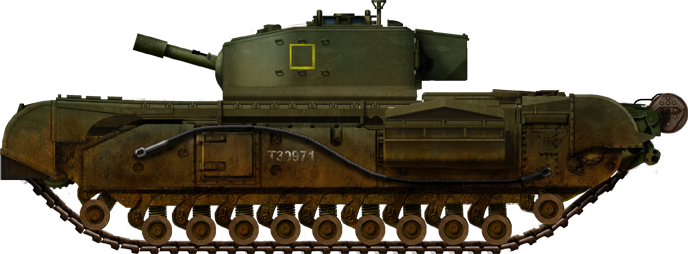
Churchill Mk.XI CS, Holland, winter 1944.
British Churchill Tank – Tank Encyclopedia Support Shirt
Sally forth in with confidence in this Churchill tee. A portion of the proceeds from this purchase will support Tank Encyclopedia, a military history research project.
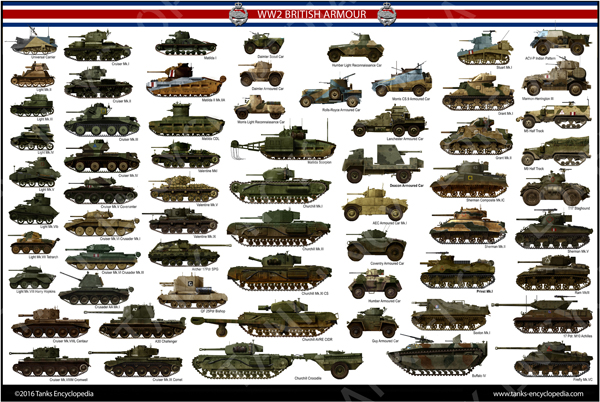 Poster of British armor of the Second World War, including Commonwealth and Lend-Lease Vehicles.
Poster of British armor of the Second World War, including Commonwealth and Lend-Lease Vehicles.
Churchils, Cromwells, Matildas and many iconic or little known British vehicles are featured! Purchase now !

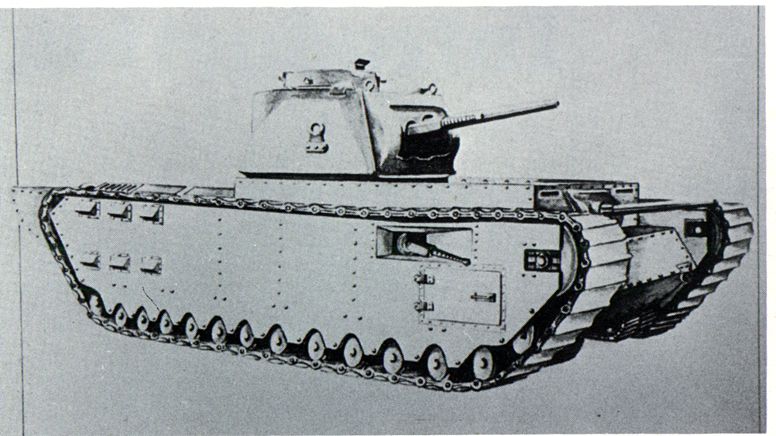
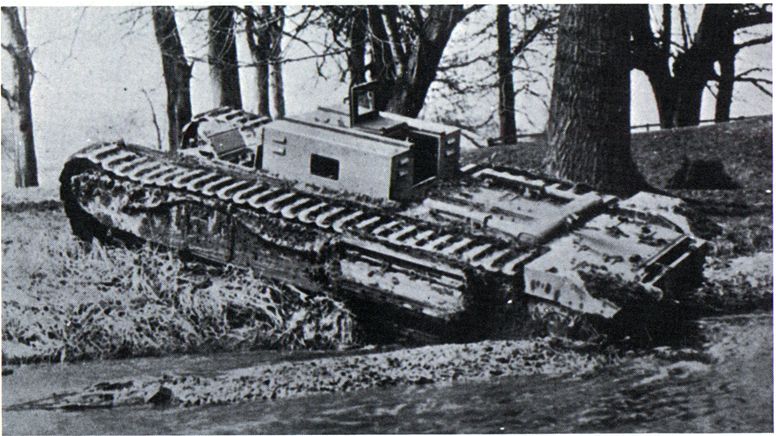
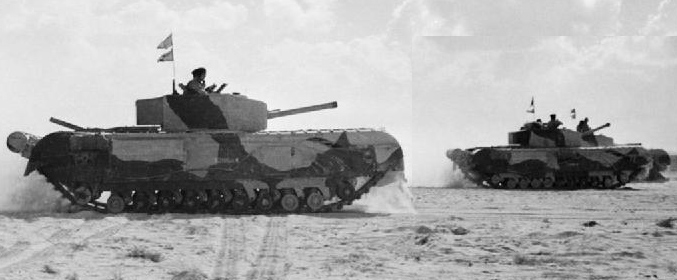
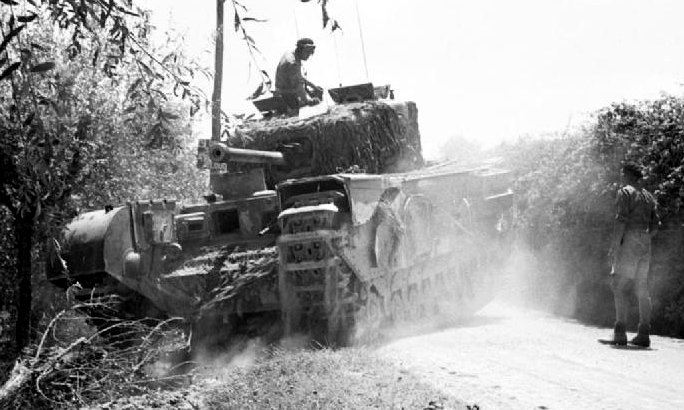
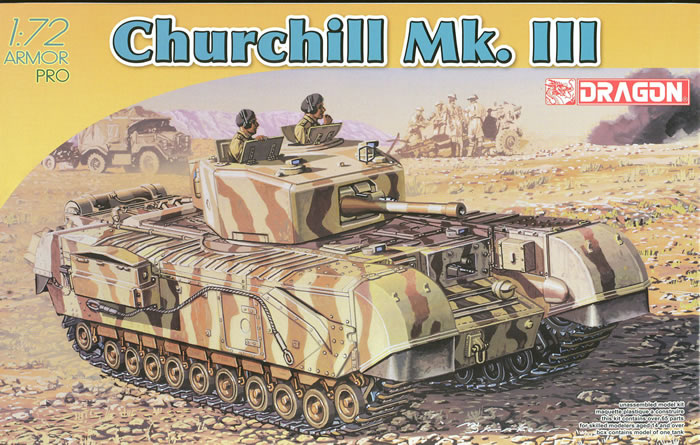
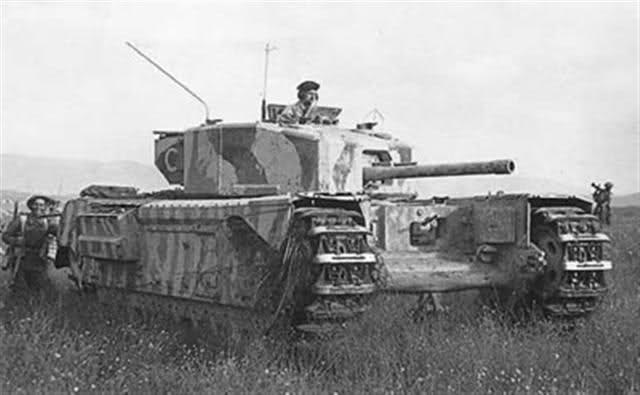

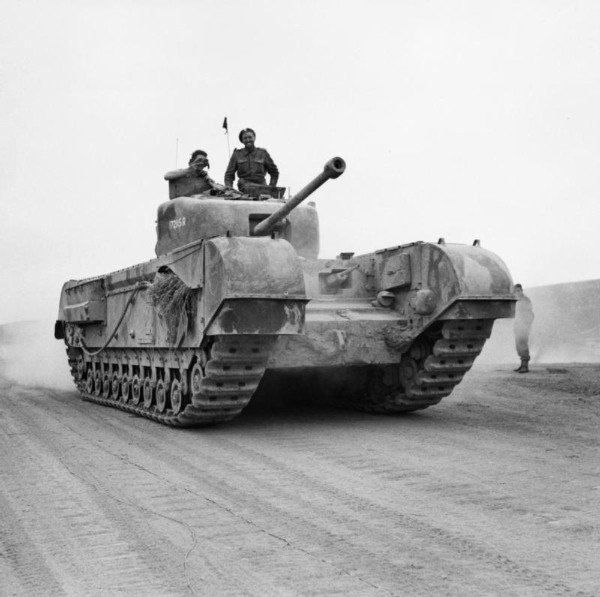
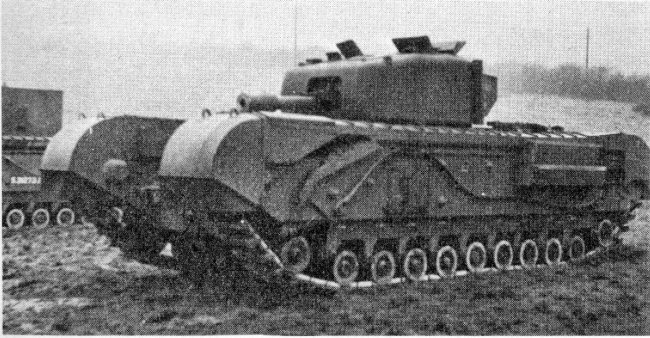
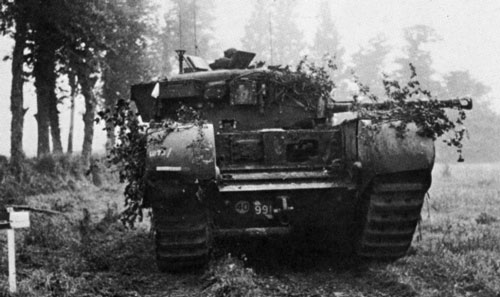
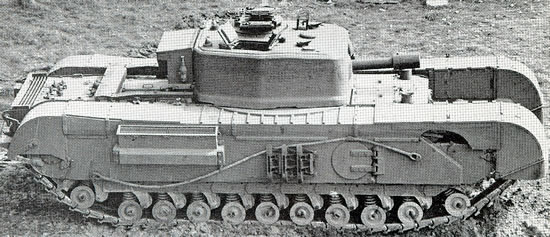
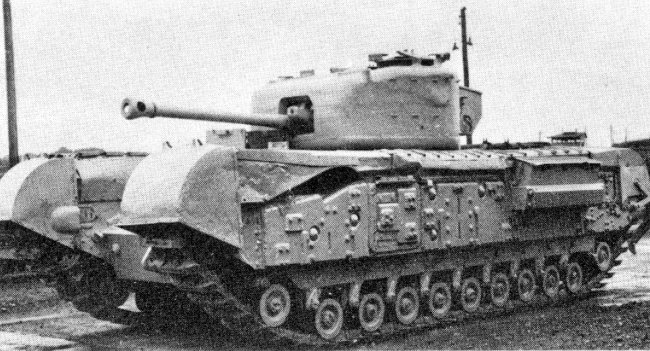
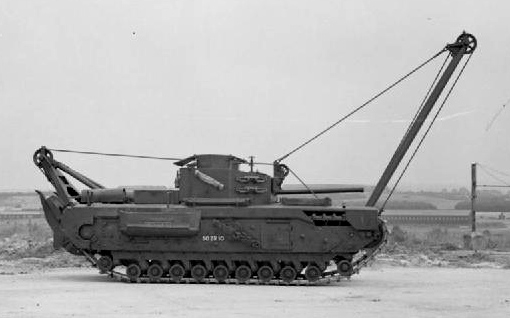
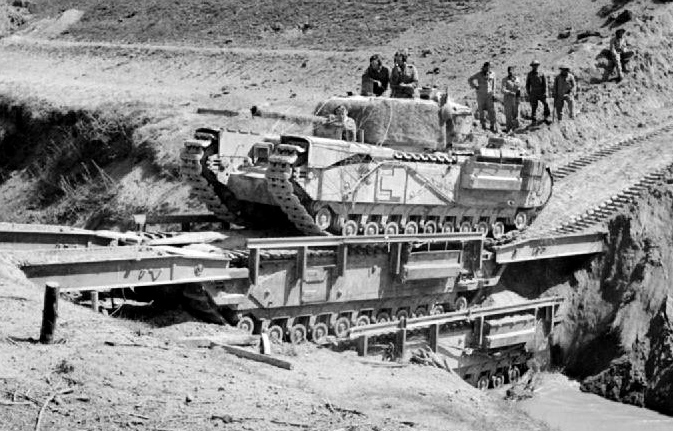
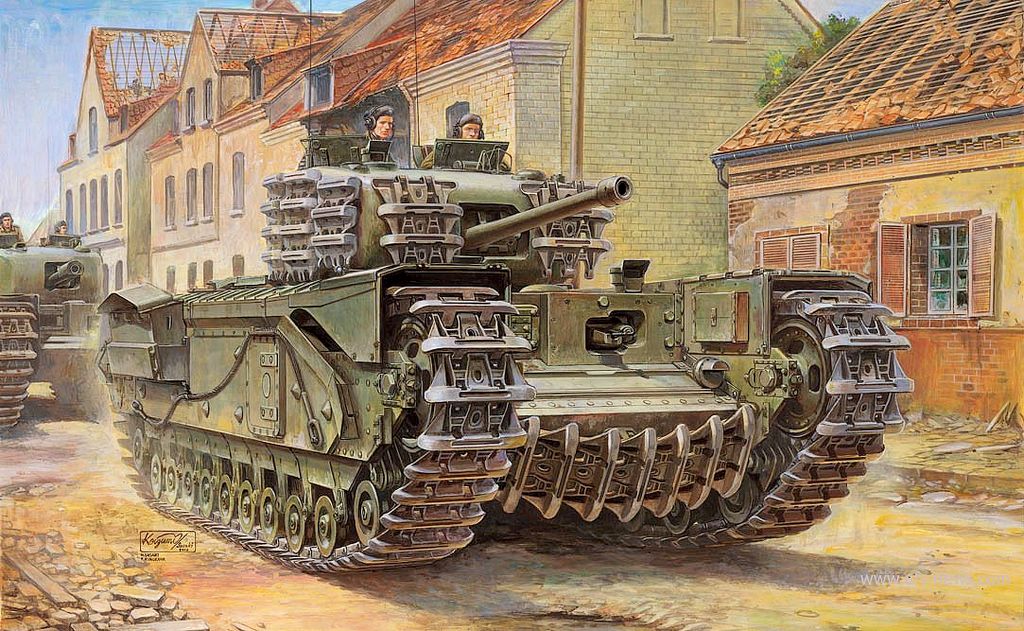
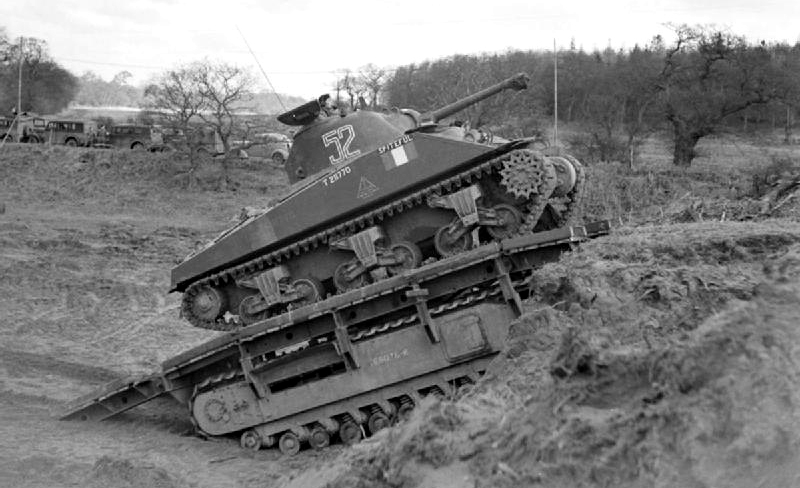
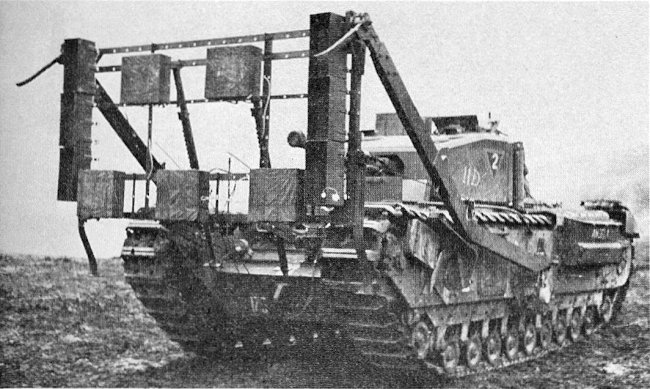
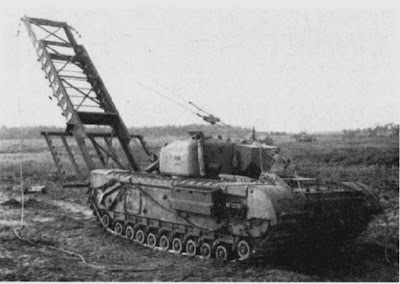
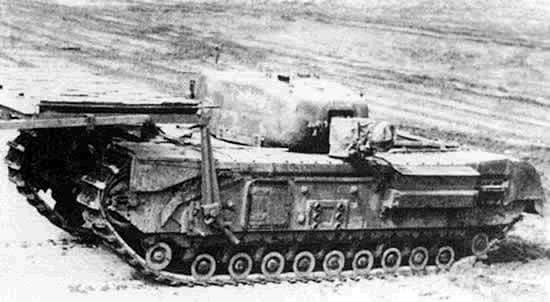
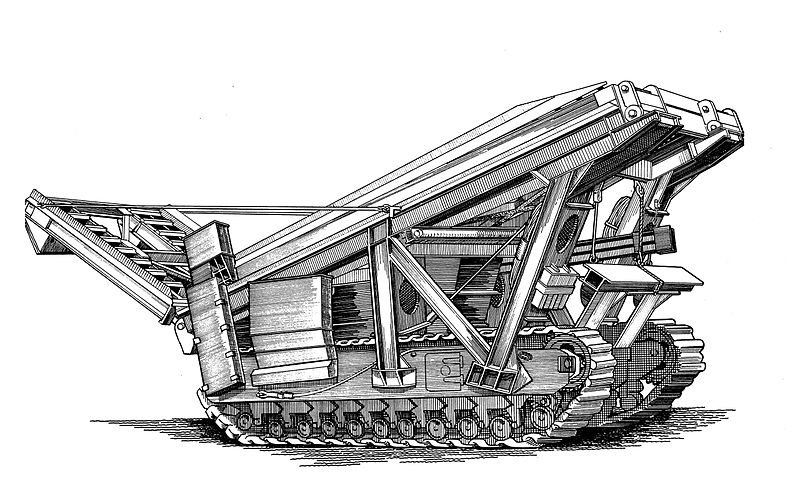
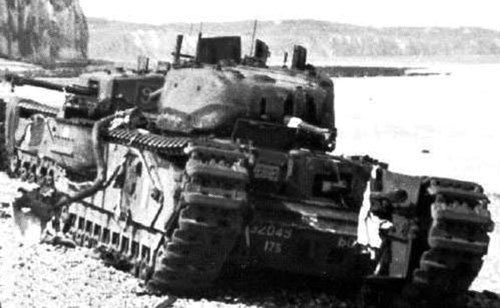
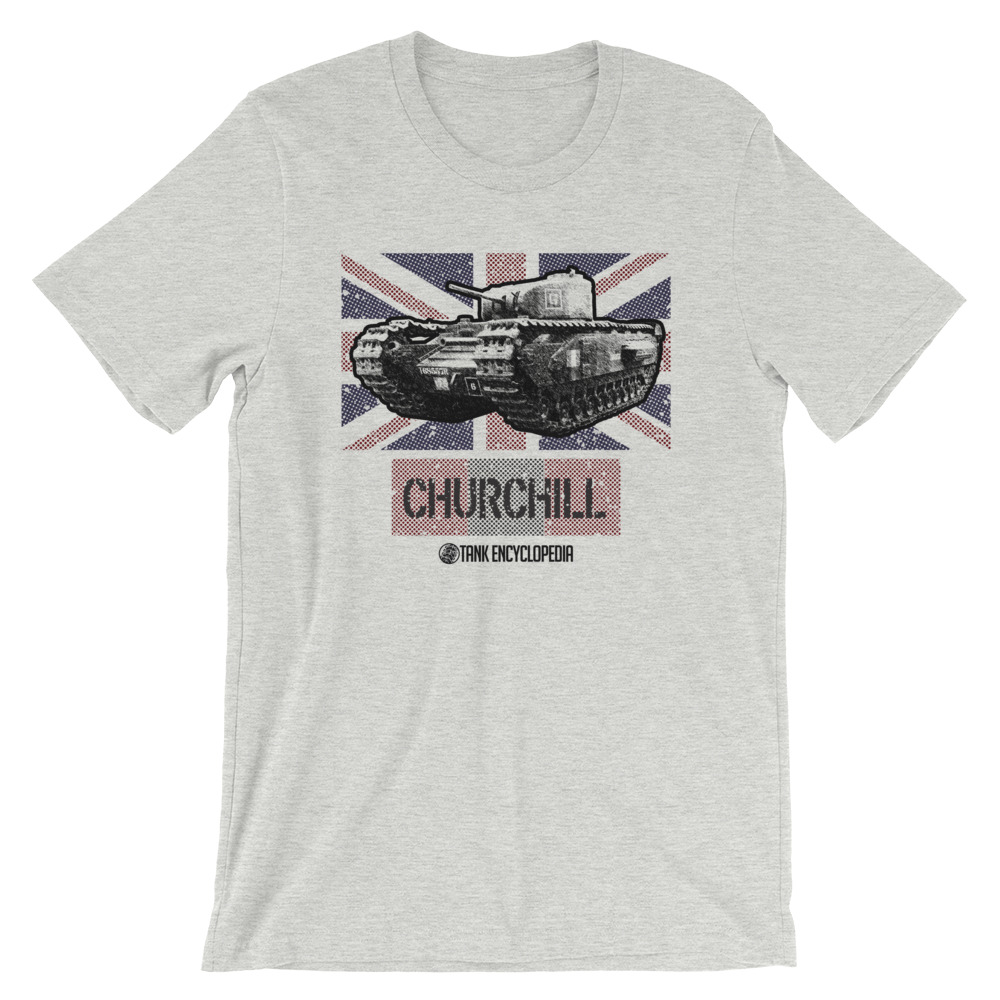
34 replies on “A.22, Infantry Tank Mk.IV, Churchill”
The Churchill never mounted the 17 pounder gun,your information is incorrect.
The Churchill was developed into the Black Prince which did in fact mount a 17 pounder and only a few were produced.
Indeed, there was a confusion between the QF 75 and the 17 pounder.
The text has been modified, thank you for notifying us!
I read that also a number of Churchills were covered in a ‘zimmeritt’ style of paste for experimentation.
As part of the order that went to Australia they were also supplied the paste.
That’s an interesting information, thanks for sharing !
Will the Black Prince have an illustration added? the ones on this sight are amazing so I’d love to see it.
Also, an addition to this page: Are you familiar with the Churchill NA 75? It was a MK IV Churchill with a Sherman’s 75mm cannon and mantlet. It was devised by one Captain Percy Morrel, REME. in 1943, he was Second in command of 665 tank troops workshop. He did it because he realised that in the sun of the African desert, the standard recessed mantlet of a churchill cast a deep shadow, making a clear aiming point for german gunners. It also gave the Gunners HE capability, as the standard 6-pdr lacked HE at the time.
Haha, never mind I’ve just seen its already here.
Your information regarding the “Gun Carrier, 3-inch, Mk I, Churchill (A22D)” is incorrect – it was a 3-inch (76.2) gun behind 88mm of armour.
See: https://en.wikipedia.org/wiki/Churchill_tank#Gun_Carrier.2C_3-inch.2C_Mk_I.2C_Churchill_.28A22D.29 and: http://www.panzercentral.com/forum/viewtopic.php?f=93&t=47775
Indeed, the legend was right, not the variant description. It was fixed, thanks !
Just a small thing, according to wikipedia, only one received more than light damage, during the second battle of El Alamein rather than none.
https://en.wikipedia.org/wiki/Churchill_tank#North_Africa
Your North Irish Horse Tunisia Churchill is marked in yellow, the NIH were senior regt in each of the 3 Tank Brigades it was in during WW11, therefore Squadron markings were always in red. B Anderson
NIH Regt Assoc N.I.
I,
Please, are the Churchill SPG, CIRD and CDL realy used by British Army (No 79th Armoured Division ?), and how much ? I’m not sure of it…
Regards,
Jean Luc Castelli
“Churchill Mk.VI
A minor upgrade of the IV, with the new 6 pounder Mk.V gun. 200 were built, but production was quickly swapped for the new VII, and the factory lines were then busy upgrading III/IV versions to the new standard.”
it was a bored 57mm QF 6 pounder, into a 75mm M2 or M3 type of US guns firing US ammo with less armor penetration but a more effective HE.
Was there ever a variant developed the had a 165mm demolition gun? I have seen some people talking about that before i didn’t know if it was real or not. Also the CDL variant of the churchill looked really intresting, never seen anything like that before
You are correct. It was a post-war variant of the Churchill AVRE. It was armed with the Ordnance BL 6.5″ Mk I, later designated as the 165mm L9 Demolition Gun. If you would like to know more about the Churchill CDL, please see our article HERE.
– TE Moderator
This was a post war variant,it effectively replaced the “Petard” mortar in the AVRE.
Concerning the Churchill engagement in Tunisia with a Tiger. I also have heard (and read) that a solid shot from one of the 6 pounder guns managed to destroy the elevation mechanism on the gun (presumably another lucky shot). How much armor did the solid shot (read and heard they accomplished this with solid shot from the 6 pounder) shatter/penetrate to destroy the elevation mechanism?
“In the end, a compromise inspired by the French B1 was chosen, with a 6-in (75 mm) hull howitzer”
The howitzer used in the early models of Churchill was a 76.2mm (3inch) as mentioned in the paragraph below. Unlike in earlier Cruiser CS tanks they did fire HE (as did the Matilda CS)
75mm is 2.95 inch not 6 inch (155mm)
Thanks for bringing this to our attention Robert! It has been fixed!
What is the reference to the Churchill II being called the 1A? Not in any of the books I have since the 1980s.
You missed out the Churchill Mk.1 CS, which (perhaps bizarrely) had 3″ howitzers in both the turret and hull. Not sure how many were made or issued, but for completeness’ sake should be included.
Also note the Aussies were going to field a regiment of Churchill Mk.VIII Crocodiles, (yes the 95mm howitzer version) but the war’s end brought that to a halt.
The Churchill 3″ Gun Carriers were issued to brigade anti-tank companies briefly, in the UK, including in a Canadian unit, but never left the UK as Gun Carriers. Some were degunned and used as Snake demolition charge carriers at Anzio I think.
It is perhaps worth noting that both Jordan and Iraq had a company of 15x Churchill VII in service in the 1950s.
I have issues with the paragraph on North Africa:
1) No Churchill Mk.1/II were sent to N Africa before Tunisia as the first sentence implies, they were all Mk.III, as you mention, in Kingforce.
2) There were TWO brigades sent to Tunisia, not one, the 21st and 25th, each of 3 regiments. The Germans send 10 Tigers or whatever it was, we sent ~300 Churchills 🙂
3) “All older version were withdrawn and shipped back to Great Britain for an overhaul.”
Definitely not, as several regiments are documented as having Churchill 1CS in N Africa, and even into the Italian campaign. The comment may refer to after the Tunisian campaign, not before, when most CS tanks in the Med were replaced by Mk.V before the campaign in Italy. Even then, a few Mk.1 appear to have been kept in service.
See for example The British Armies in WW2 an Organisational History Volume 4, David Hughes, DA Ryan, S Rothwell, Nafziger (2002) ISBN 1-58545-085-5 pg.10 mentions 21st Tank brigade having 12x Churchill I CS. Page 11 shows 12th RTR still with 6x Churchill I CS in Sept 1943 for example.
25th Tank Brigade’s 51st RTR had 6x Churchill I CS in Feb 1943 (Ibid, pg.12)
4) ” Despite being fitted with a 75 mm (2.95 in) howitzer” … Really? 76.2mm 3″
Hello Mark!
Would you be interested in joining our team and rewriting the Churchill article?
All the best,
Lucian
Hi Lucian, I’d love to if I had the time! It’s something I’ve thought about in the past (eg I really need to submit an article on the “No 2pdr HE” myth) but haven’t dared commit the time. Being self-employed I give too much time away for free already. If I doubled the sales of my MicroMark army lists and ten-fold increased book sales, then I could. Thanks for the offer though!
Hey Mark!
We can offer you some ads on our website on certain articles if it would help convince you.
All the best,
Lucian
Hmmmm, interesting! Lucian, you’d better email me off forum,
Mark
But even before that, a clever and resourceful officer, named Percy Lowell, managed to fit spare US-built 75 mm (2.95 in) guns inside the regular Churchill IV turrets, obtained from countless disabled Sherman tanks. The result, known as the “NA-75”, (…)”
The surname was: Morell, not Lowell – captain Percy H. Morell. You have its correct on the page about NA 75.
Fixed, thank you!
Oh no, what did you do with the page layout?? It was such a synoptic and user friendly layout. You was abel to whatch over all in seconds. Now, its a scroll wolve. And really heavie to use and timeconsuming. Please, redo it.
J
Thanks for your site. Main armement of the Churchill Mk VI is the british 75mm Mk V not a 6-pdr III/V
Tapping out the tank name, I hadn’t expected such an encyclopaedic, scholarly response. Thank you. It took Britain a long time to adopt the carriage form of Australian Lancelot de Mole’s 1912 “mobile fortress” names like “land ship” RN piloted and the deception “tank” lying in a desperate future. De Mole submitted his design and model (now in our Canberra Commonwealth War Museum) pre Great War, rejected by Britain because its design anticipating rôles such as a trench traverser would never be required, as trenches weren’t cricket, let alone a threat to the Empire on whose cavalry the Sun never set.
You mentionned “The 58 track links rolled under 22 paired ground..” : Are you sure about the 58 value ? I restore an Mk IV version and the line seem to be higher (70 to 72)..
There were at least 2 Churchill tanks (unknown marks) at the beginning of rocket research activity at Westcott (ca 1946/47). One was used as a shelter located close to rocket firing bays to give scientists a close view of the test and provide protection during the test.
The other tank was fitted with rockets in an attempt to ‘lift’ the tank out of the lagoon to prove out a system to recover the tank. This failed. Do you have any information about Churchill tanks at Westcott?
your info box at the bottom says “.303 Besa machine guns”. the Besa is famous for being chambered in 8x59mm Mauser and not the typical .303 round used by all other British MGs.
also, a “Q-ship” is a merchant vessel with camouflaged guns intended to destroy Uboats that come close. not a “Q” boat, not a destroyer. a destroyer in WW1 was a little cockleshell affair, often with multiple stacks and a slim, fast hull. there is no way to disguise one as a merchant vessel.
Can we drop the whole cliche ‘it did poorly at Dieppe’ this is absolute BS. Dieppe was an unmitigated disaster. It was a poor plan, with a poor premise. The Dieppe raid was completely flawed from the outset.
The Churchills performed better than anything else, and they are the reason why they could evacuate some of the assaulting forces. No other vehicle could move on the chert pebbles, 8 tanks were immbolised by the pebbles, three by enemy fire. The tanks could not advance into Casino as the infantry engineers became pinned down and could not demolish obstacles.
When the order to retreat was given the tanks fell back to the beach they sheltered the infantry with their hulls. Hence why you have photos of them wrecked on the beach, but parallel with the sea.
Out of every hit the vehicles took only two penetrated and these did not lead to tank fires. The tanks could not be destroyed when they were abandoned as there was still injured infantrymen sheltering behind them when the tank crews were evacuated.
One tank out of 21 landed was evacuated. That one vehicle of 21 got off that beach is a testament of the protection, hardiness and terrain crossing capability of the tank.
The illusitrated tank ‘Shorty’ would be a Mk III* (MkIII ‘star’)Which is a MkIII upgraded with a 75mm gun. It additionally has applique armour.